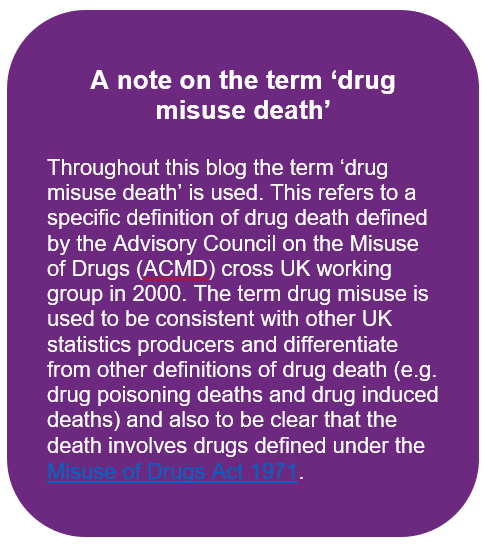Scotland’s drug death rates have increased considerably over the last two decades.
This blog sets out what is being included in the figures. It explains why it can still be concluded that Scotland has a much higher rate of deaths from drugs than the rest of the UK, despite some differences in how deaths are counted.
NRS use a definition of drug deaths that only includes deaths where controlled drugs were present. ‘Controlled drugs’ means those that are listed under the Misuse of Drugs Act (1971). This includes recreational drugs such as cocaine and heroin but also some prescribed drugs such as tramadol. In addition, we only count deaths where the drug use directly caused the death.
This definition of drug deaths is called ‘drug misuse deaths’ and is considered the most appropriate way to count drug deaths. This is the main headline figure NRS report in Scotland each summer.
When drug deaths in Scotland are compared with the rest of the UK, a wider definition (called ‘drug poisoning deaths’) is used, and this includes deaths from drugs which are not controlled. This is because in Scotland we collect more information on the type of substances involved in drug deaths and therefore our drug misuse death figures are more accurate than those for the rest of the UK.
Drug misuse deaths is the headline figure in Scotland, while drug poisoning deaths is a more accurate comparator with the rest of the UK.

All drug misuse deaths are also counted as drug poisoning deaths

The drug misuse deaths figure only includes deaths where controlled substances were present and where the deaths were caused by the direct effect of drugs
Some examples:
- Scenario 1: A person took an overdose of cocaine and this caused a heart attack which led to that person’s death. This would be counted as both a drug misuse and drug poisoning death because acute drug use directly led to the death.
- Scenario 2: A person had been using cocaine for years. Over time this contributed to a weakening of their heart and damage to their arteries. This damage eventually caused a fatal heart attack. This would not be counted as a drug misuse death because the long term drug use did not directly lead to the death. It would still count as a drug poisoning death
- Scenario 3: A person died of a blood borne virus which they got by injecting drugs with non-sterile needles. This would not be counted as a drug misuse or drug poisoning death because it was the virus associated with drug use rather than the drug itself that caused the death
- Scenario 4: A person dies in a road traffic accident after driving under the influence of controlled drugs. This does not count as a drug misuse death or a drug poisoning death
NRS use expert advice from consultants in Public Health Scotland to determine whether individual deaths should be included or not.
Why do we use drug poisoning deaths for UK comparisons?
The methods used for collecting drug death data differ across the UK.
All countries use information from the death certificate to identify the cause of death and whether specific drugs were involved. In Scotland, when drugs are identified by a post-mortem, NRS receive a form from the pathologist with all of the drugs found in the body listed on it.
In England and Wales (ONS) and Northern Ireland (NISRA), they have the information which is recorded on the death certificate but do not receive extra information from the pathologist. This means that the other UK countries have less information on which drugs are found in the body than in Scotland. If the drugs involved are unspecified, then the death cannot be counted as drug misuse.
In Scotland, only around 2% of all drug deaths had unspecified drugs. By contrast, in England and Wales around 25% of all drug deaths had unspecified drugs. This means that the drug misuse figures for the different UK countries could be underestimated by quite different amounts.
The drug poisoning figures are not affected by this issue, so this is a better definition for comparing death rates across the UK.
Whichever definition is used, it remains the case that Scotland has a much higher drug death rate than anywhere else in the UK. The scale of the difference under either definition highlights that differences in production of the statistics do not explain the gap.
Number of drug deaths per 100,000 people1 In 2021

ONS have published a blog which goes into more detail on this.

One thought on “What actually counts as a drug death?”